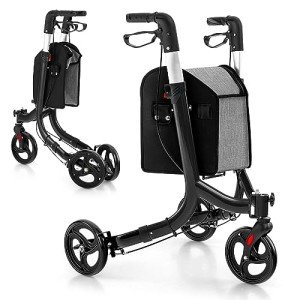
Walker With Seat
Add a review FollowOverview
-
Founded Date April 6, 1992
-
Sectors Electrical Engineering
-
Posted Jobs 0
-
Viewed 75
Company Description
The 10 Most Scariest Things About Medical Walker
Understanding Medical Walkers: A Comprehensive Guide
Medical walkers function as vital mobility aids for people recovering from surgery, managing chronic diseases, or handling age-related COSTWAY 4-Wheel Mobility Walker with Seat concerns. These devices not just improve physical independence but also improve safety, enabling users to navigate their environments with higher ease. This article explores the types, benefits, features, and considerations related to medical walkers, along with some frequently asked questions.

Table of Contents
- Types of Medical Walkers
- Benefits of Using a Medical Walker
- Key Features to Consider
- Frequently Asked Questions
- Conclusion
1. Kinds Of Medical Walkers
Medical walkers are available in numerous styles, dealing with various requirements and preferences. The primary types consist of:
| Type of Walker | Description |
|---|---|
| Requirement Walker | A rectangle-shaped frame Rollator With Storage 4 legs, providing stability and support. |
| Two-Wheeled Walker | Comparable to a basic walker however equipped with wheels at the front for easier motion. |
| Three-Wheeled Walker | A lightweight walker with three wheels, enabling more maneuverability, suitable for indoor use. |
| Bariatric Rollator Walker | A walker with four wheels, hand brakes, and a seat, appropriate for longer ranges and resting requirements. |
| Hemi Walker | Designed for individuals who can use just one hand, including a tripod-like style. |
2. Benefits of Using a Medical Walker
Using a medical walker provides a number of benefits that contribute to the user’s total wellness, including:
- Increased Stability: Walkers offer a stable base of assistance, reducing the danger of falls.
- Enhanced Mobility: They allow users to walk around more easily, promoting self-reliance.
- Pain Relief: By rearranging weight, walkers can relieve discomfort in the joints, especially in the hips and knees.
- Posture Support: These gadgets motivate appropriate posture, lowering pressure on the back.
- Enhanced Confidence: Users frequently feel more safe and secure utilizing walkers, causing better self-confidence and increased activity levels.
3. Secret Features to Consider
When selecting a medical walker, it’s crucial to evaluate various features to discover the best fit. Here are some critical aspects to think about:
- Weight Capacity: Ensure the walker can support the user’s weight while preserving stability.
- Height Adjustment: Look for a walker with adjustable height settings to accommodate the user’s height and offer comfy grip.
- Material: Lightweight aluminum walkers are much easier to maneuver, while steel walkers provide stronger support but may be heavier.
- Wheel Quality: If selecting a wheeled walker, think about the wheel size and tread. Bigger wheels navigate unequal surface areas more easily.
- Seat Availability: If users will be walking for longer durations, a walker with an integrated seat can provide rest breaks when needed.
- Brakes: Hand brakes are particularly crucial for safety in Rollator With Basket walkers to manage speed and stop when needed.
Types of Walkers with Features Comparison Table
| Walker Type | Weight Capacity | Height Adjustment | Wheels | Seat Available | Brakes |
|---|---|---|---|---|---|
| Standard Walker | Approximately 300 pounds | Yes | No | No | No |
| Two-Wheeled Walker | As much as 300 lbs | Yes | Yes | No | No |
| Three-Wheeled Walker | Approximately 250 lbs | Yes | Yes | No | No |
| Rollator For Hiking Walker | Approximately 400 pounds | Yes | Yes | Yes | Yes |
| Hemi Walker | As much as 250 pounds | Yes | No | No | No |
4. Regularly Asked Questions
Q1: Who need to use a medical walker?A: Medical walkers are useful for individuals recuperating from surgery, experiencing balance issues, or needing help due to age-related mobility challenges. Q2: Can a medical walker be adjusted?A: Yes, a lot of
medical walkers are height-adjustable to accommodate different user heights, permitting a more comfy grip. Q3: How do I select the best walker for my needs?A: Consider factors such as the
user’s weight, height, kind of mobility problems, and whether they require a seat or brakes. Testing the walker for comfort and stability before purchase is also a good idea. Q4: Are there any safety ideas connected with utilizing a medical walker?A: Yes, users need to ensure they do not lean too
greatly on the walker, use it on steady and level surfaces, and always ensure
the brakes are engaged when seated or fixed. Q5: Can walking with a medical walker aid with rehabilitation?A: Absolutely. Medical walkers are typically suggested as part of rehabilitation programs as they motivate
physical activity, which aids in healing and mobility enhancement. 5.
Conclusion Medical walkers play an important role in improving the lifestyle for people dealing with mobility challenges. With various types and functions readily available, selecting the right walker involves thinking about the user’s particular requirements and circumstances. By comprehending their benefits and correct use, individuals can restore independence, improve their mobility, and browse their environments safely. Whether for short-term recovery or long-lasting support, the right medical walker can substantially enhance a user’s overall well-being. Integrating a medical walker into one’s daily routine can be a transformative choice, making it simpler to get involved in life’s everyday activities while guaranteeing safety and self-confidence.
